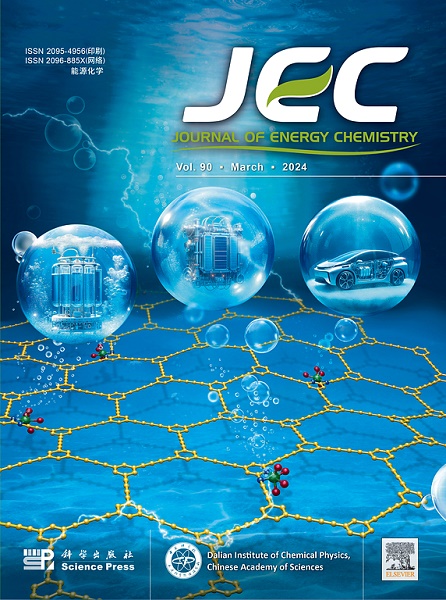不饱和氧配位CuCo合金表面的d-p电子耦合在温和条件下促进n -杂芳烃加氢
IF 13.1
1区 化学
Q1 Energy
引用次数: 0
摘要
开发温和条件下n-杂芳烃加氢的高效非贵金属催化剂具有重要的理论意义和工业应用价值,可有效降低能源消耗和环境污染。在本研究中,我们发现制备的CoCu纳米合金催化剂(命名为Co1Cu1/C)在空气中暴露24 h后,在温和的反应条件下(60°C, 3 MPa H2),喹啉加氢的催化性能显著提高(产率从微量到99%)。表征表明,催化剂Co1Cu1/C表现出Co和Cu之间较强的相互作用。同时,它具有稳定的部分氧化表面。Co1Cu1/C的不饱和氧配位表面对喹啉和1,2,3,4 -四氢喹啉具有适度的结合,可以有效地避免催化剂失活,有利于加氢动力学。密度泛函理论(DFT)计算和基于X射线的结构分析表明,不饱和氧配位表面可以降低活性氢的扩散能和喹啉氢化反应势垒,这是由d-p轨道电子耦合引起的。本研究揭示了纳米合金催化剂的催化性能可能不仅仅归因于金属之间的相互作用,金属表面的不饱和氧配位也起着重要的作用。本文章由计算机程序翻译,如有差异,请以英文原文为准。

The d-p electron coupling over the unsaturated oxygen coordinated CuCo alloy surface for enhanced N-heteroarenes hydrogenation under mild conditions
The development of highly efficient non-noble metal catalysts for the hydrogenation of N-heteroarenes under mild condition is of great importance for both theoretical and industrial applications, which can efficiently reduce energy consumption and environmental pollution. In this work, we found that the prepared CoCu nano-alloy catalyst after exposed in the air over 24 h (named Co1Cu1/C) exhibited a dramatically improved catalytic performance (yield from trace to >99%) for quinoline hydrogenation under mild reaction conditions (60 °C, 3 MPa H2). According to the characterization, the catalyst Co1Cu1/C exhibited the strong interaction between Co and Cu. Meanwhile, it was endowed with a stable partial oxidation surface. The unsaturated oxygen coordinated surface of Co1Cu1/C presented a moderate binding for quinoline and 1, 2, 3, 4-tetrahydroquinoline, which could efficiently avoid the deactivation of catalyst and favor the hydrogenation kinetics. The density functional theory (DFT) calculations coupled with X ray-based structural analyses suggested that the unsaturated oxygen coordinated surface could lower the diffusion energy of the active hydrogen species and the reaction barrier for quinoline hydrogenation which resulted from the d-p orbital electron coupling. This work revealed that the catalytic performance of nano-alloy catalysts might not only be ascribed to the interaction between metals, while the unsaturated oxygen coordination of metallic surfaces played an important role.
求助全文
通过发布文献求助,成功后即可免费获取论文全文。
去求助
来源期刊

Journal of Energy Chemistry
CHEMISTRY, APPLIED-CHEMISTRY, PHYSICAL
CiteScore
19.10
自引率
8.40%
发文量
3631
审稿时长
15 days
期刊介绍:
The Journal of Energy Chemistry, the official publication of Science Press and the Dalian Institute of Chemical Physics, Chinese Academy of Sciences, serves as a platform for reporting creative research and innovative applications in energy chemistry. It mainly reports on creative researches and innovative applications of chemical conversions of fossil energy, carbon dioxide, electrochemical energy and hydrogen energy, as well as the conversions of biomass and solar energy related with chemical issues to promote academic exchanges in the field of energy chemistry and to accelerate the exploration, research and development of energy science and technologies.
This journal focuses on original research papers covering various topics within energy chemistry worldwide, including:
Optimized utilization of fossil energy
Hydrogen energy
Conversion and storage of electrochemical energy
Capture, storage, and chemical conversion of carbon dioxide
Materials and nanotechnologies for energy conversion and storage
Chemistry in biomass conversion
Chemistry in the utilization of solar energy
 求助内容:
求助内容: 应助结果提醒方式:
应助结果提醒方式:


